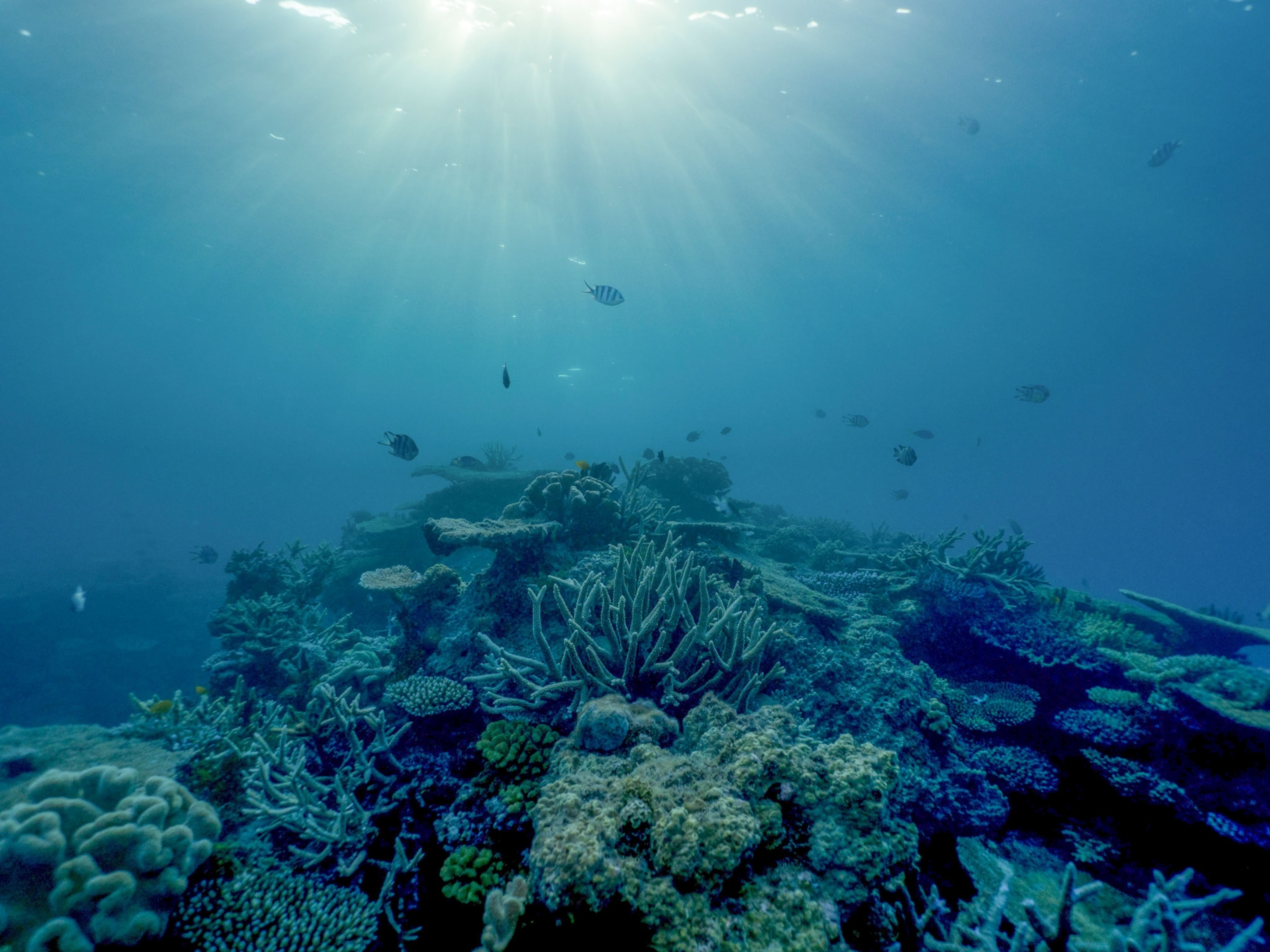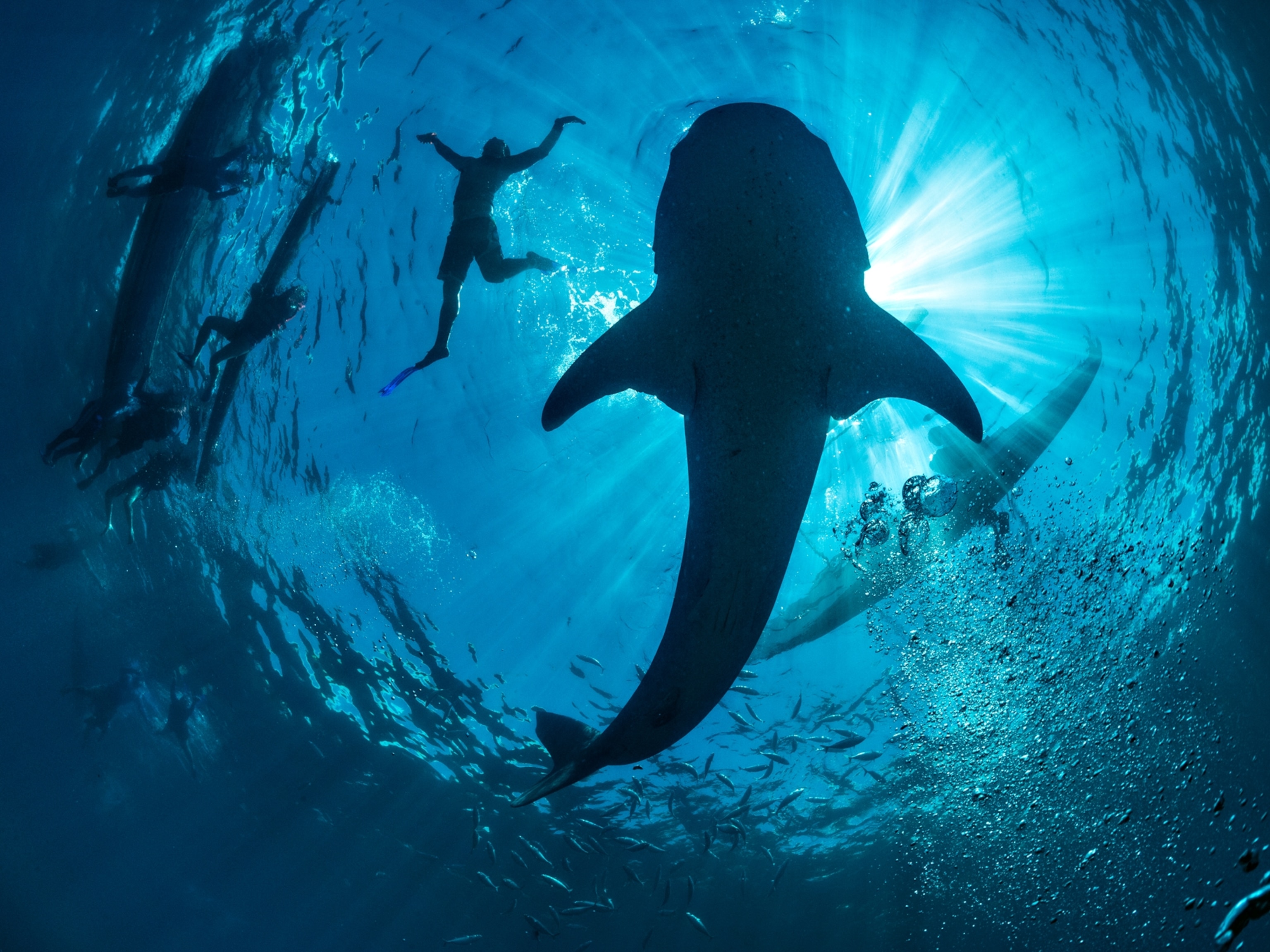
These fish eggs aren't hatching. The culprit? Light pollution.
When exposed to artificial light at night, charismatic clownfish try to breed—but no eggs hatch.
Bright orange clownfish, of Finding Nemo fame, face a slew of problems in the wild, from overharvesting for home aquaria, to bleaching of their coral and anemone homes by climate change-induced warming waters. And now there’s a third prong on this deadly trident: light pollution.
Published today in Biology Letters, a new study reveals that clownfish, which are dependent on coral reefs, can’t raise any young when exposed to artificial light.
The human-made light that is spewed over Earth endangers animals across ecosystems. Nighttime lights alter birds’ nocturnal migrations. Plants bloom earlier. Sea turtles avoid nesting on brightly-lit beaches. Songbirds start warbling earlier.
“But we don’t think about underwater marine systems being potentially impacted,” says Emily Fobert, a marine ecologist at Flinders University in Australia and lead author of the study.
“I wasn’t expecting the result [in the paper] to be that nothing hatched,” says Thomas Davies, a conservation ecologist from Bangor University in Wales. “It’s quite worrying…a really big result that speaks to how light pollution can have a really big impact on marine species.”
Clownfish shack up for science
Fobert and colleagues looked at 10 pairs of clownfish in a lab—each clownfish pair had their own aquarium “love shack.” Half of the tanks experienced typical light as they would on a natural coral reef—12 hours of light and 12 hours of darkness. But the other half experienced a low level of artificial light at night, mimicking light pollution from an average coastal town.
Researchers counted how often the fish spawned, how many eggs were fertilized, and how many eggs hatched over the next 60 days.
The results were staggering: “No fish hatched when the light was present,” says Fobert. The clownfish exposed to artificial light at night still spawned, and the eggs were still fertilized at a similar level as the normal fish. But there was no hatching.
As soon as the researchers removed the light at night, hatching resumed and jumped back to match the hatching rate of the normal fish.
Before hatching, the eggs undergo a color change, becoming quite silvery. All eggs turned shiny, and the eggs under a normal light-dark cycle hatched. But researchers watched for several days as the eggs exposed to light at night didn’t hatch. The silver color disappeared, and the egg turned opaque.
To invest all that time and energy and have no eggs hatch is almost the bigger tragedy, said Karen Burke da Silva, a co-author at Flinders University, clownfish expert, and director of the organization Saving Nemo.
“Parents were awake longer at night and they were taking enormous care of these big beautiful embryos,” says Burke da Silva.
The smaller males care for the eggs, fanning them and mouthing them to clean them. Because reproduction for these fish is incredibly energetically costly, said Fobert, there could be consequences that have yet to be measured.
Stephen Swearer, a marine biologist at University of Melbourne in Australia and co-author of the study, said although they didn’t see a drop in spawning and fertilization rates in the study, higher light levels—like a pier light 2,000 times brighter than a full moon—could cause a bigger impact.
Glowing marine systems
Artificial light at night radiates from any developed area: houses, streetlights, hotels, and offices. Almost 80 percent of people worldwide live in areas with light pollution. And the problem is only increasing—with the switch to cheaper, more energy efficient LED lights—by more than 2 percent each year.
But LED lights often emit more light in shorter wavelengths—blue light. In humans, blue light triggers a cascade of health effects—including disrupting sleep—by interrupting normal cycling of the hormone melatonin. And it’s that blue light that penetrates more deeply into the water and can disrupt natural systems most, said Fobert.
Animals have evolved their internal clocks—when to feed and have babies, or when to sleep—based off night and day timing. Exposure to light during a period that is supposed to be dark confuses biological rhythms.
For tiny clownfish babies, the onset of darkness triggers their eggs to hatch during a safer period, avoiding predation. Fobert speculates that exposure to light during critical hours after dusk most likely causes this reduction in hatching. If it were dark during key hours, the eggs might still hatch.
Damon Bolton, a marine ecologist at University of New South Wales in Australia uninvolved with the study, says that for a lot of animals, evolution has been closely tied to light signals, so the results from this study go beyond clownfish to other marine organisms. But Davies cautions that “it’s probably a big leap to apply this [result] to all fish.”
We might not see such a drastic effect on reproduction for other species, but different life stages, like the early larval period, could experience changes.
It’s quite worrying…a really big result that speaks to how light pollution can have a really big impact on marine species.Thomas Davies, Eologist at Bangor University
Looking beyond individual organisms, to communities of species and their interactions, is critical, said Bolton. “If these eggs aren’t hatching because they aren’t getting their light cue...then maybe a predator isn’t getting their food source, and you can chase this effect through the food web,” he says.
How bright is Nemo’s future?
In the wild, clownfish use anemones for their individual love shacks, with one pair per anemone. Most clownfish live in shallower water, within 30 feet of the water surface. Fish living in deeper water won’t be impacted by light as much, says Fobert, but light will definitely reach fish like clownfish.
Clownfish pairs at shallow depths could “really be stuck in a poor situation,” says Burke da Silva. Finding a new anemone with less light would be difficult because good anemones are already taken—clownfish are territorial and guard their homes fiercely. An open anemone farther away might attract them, but clownfish are poor swimmers, so moving away isn’t a good option.
“Artificial light can have impacts with severe consequences for populations,” said Davies. “Zero percent hatching is essentially no recruiting to the next generation and could cause extinction in a species. It’s quite profound.” At least in a localized area, the population would blink out.
Researchers ran the experiment for several months, so this study only peeked into the possible effects from light pollution. “The research is really exciting, but it just opens up so many more questions. We are just scraping the surface,” says Fobert.
Swearer says the next steps are looking at how light pollution affects clownfish in the long term. Since clownfish can live for at least 30 years, it will be important to understand if the fish can adapt to light, or if they can’t have any babies during their whole lifespan.
“While it’s depressing, there is still hope,” says Bolton. Don’t count these charismatic clownfish out just yet.
Related Topics
You May Also Like
Go Further
Animals
- How can we protect grizzlies from their biggest threat—trains?How can we protect grizzlies from their biggest threat—trains?
- This ‘saber-toothed’ salmon wasn’t quite what we thoughtThis ‘saber-toothed’ salmon wasn’t quite what we thought
- Why this rhino-zebra friendship makes perfect senseWhy this rhino-zebra friendship makes perfect sense
- When did bioluminescence evolve? It’s older than we thought.When did bioluminescence evolve? It’s older than we thought.
- Soy, skim … spider. Are any of these technically milk?Soy, skim … spider. Are any of these technically milk?
Environment
- Are the Great Lakes the key to solving America’s emissions conundrum?Are the Great Lakes the key to solving America’s emissions conundrum?
- The world’s historic sites face climate change. Can Petra lead the way?The world’s historic sites face climate change. Can Petra lead the way?
- This pristine piece of the Amazon shows nature’s resilienceThis pristine piece of the Amazon shows nature’s resilience
- Listen to 30 years of climate change transformed into haunting musicListen to 30 years of climate change transformed into haunting music
History & Culture
- Meet the original members of the tortured poets departmentMeet the original members of the tortured poets department
- Séances at the White House? Why these first ladies turned to the occultSéances at the White House? Why these first ladies turned to the occult
- Gambling is everywhere now. When is that a problem?Gambling is everywhere now. When is that a problem?
- Beauty is pain—at least it was in 17th-century SpainBeauty is pain—at least it was in 17th-century Spain
Science
- Here's how astronomers found one of the rarest phenomenons in spaceHere's how astronomers found one of the rarest phenomenons in space
- Not an extrovert or introvert? There’s a word for that.Not an extrovert or introvert? There’s a word for that.
- NASA has a plan to clean up space junk—but is going green enough?NASA has a plan to clean up space junk—but is going green enough?
- Soy, skim … spider. Are any of these technically milk?Soy, skim … spider. Are any of these technically milk?
Travel
- Could Mexico's Chepe Express be the ultimate slow rail adventure?Could Mexico's Chepe Express be the ultimate slow rail adventure?
- What it's like to hike the Camino del Mayab in MexicoWhat it's like to hike the Camino del Mayab in Mexico







